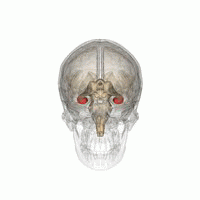
Photo from wikipedia
BACKGROUND Clinical reports suggest that rather than directly driving cocaine use, stress may create a biological context within which other triggers for drug use become more potent. We hypothesize that… Click to show full abstract
BACKGROUND Clinical reports suggest that rather than directly driving cocaine use, stress may create a biological context within which other triggers for drug use become more potent. We hypothesize that stress-induced increases in corticosterone "set the stage" for relapse by promoting endocannabinoid-induced attenuation of inhibitory transmission in the prelimbic cortex (PL). METHODS We have established a rat model for these stage-setting effects of stress. In this model, neither a stressor (electric footshock) nor stress-level corticosterone treatment alone reinstates cocaine seeking following self-administration and extinction, but each treatment potentiates reinstatement in response to an otherwise subthreshold cocaine priming dose (2.5 mg/kg, intraperitoneal). The contributions of endocannabinoid signaling in the PL to the effects of stress-level corticosterone on PL neurotransmission and cocaine seeking were determined using intra-PL microinfusions. Endocannabinoid-dependent effects of corticosterone on inhibitory synaptic transmission in the rat PL were determined using whole-cell recordings in layer V pyramidal neurons. RESULTS Corticosterone application attenuated inhibitory synaptic transmission in the PL via cannabinoid receptor type 1 (CB1R)- and 2-arachidonoylglycerol-dependent inhibition of gamma-aminobutyric acid release without altering postsynaptic responses. The ability of systemic stress-level corticosterone treatment to potentiate cocaine-primed reinstatement was recapitulated by intra-PL injection of corticosterone, the CB1R agonist WIN 55,212-2, or the monoacylglycerol lipase inhibitor URB602. Corticosterone effects on reinstatement were attenuated by intra-PL injections of either the CB1R antagonist, AM251, or the diacylglycerol lipase inhibitor, DO34. CONCLUSIONS These findings suggest that stress-induced increases in corticosterone promote cocaine seeking by mobilizing 2-arachidonoylglycerol in the PL, resulting in CB1R-mediated attenuation of inhibitory transmission in this brain region.
Journal Title: Biological Psychiatry
Year Published: 2018
Link to full text (if available)
Share on Social Media: Sign Up to like & get
recommendations!